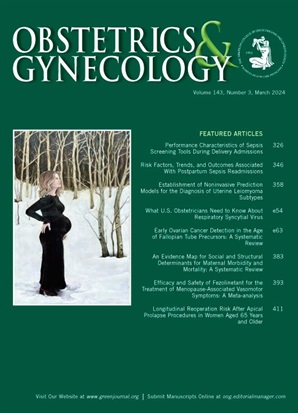剖宫产围手术期严重并发症。
IF 4.7
2区 医学
Q1 OBSTETRICS & GYNECOLOGY
引用次数: 0
摘要
目的探讨剖宫产患者围手术期严重手术并发症的发生率及危险因素。方法:这是一项回顾性横断面研究,研究对象是2016年至2021年间在加州任何一家医院接受剖宫产的患者。关联的出生证明和产妇出院数据确定了剖宫产住院。我们构建了围手术期严重手术并发症的综合指数,包括腹内或盆腔内脏和血管损伤、子宫切除术、盆腔或腹膜后血肿、伤口并发症、肠梗阻或肠梗阻、急性腹膜炎和休克。严重围手术期手术发病率总体量化,并通过产前和产时剖宫产分层。我们开发了一个多变量泊松对数线性回归模型来识别严重围手术期并发症的独立危险因素。在二次分析中,通过产前和产中剖宫产分别评估围手术期严重手术的发病率、患病率和危险因素。结果594,655例剖宫产患者中,10,182例(171/10,000,95% CI, 168-175)围手术期手术并发症严重。最常见的分类发病率是伤口并发症(59/10,000,95% CI, 57-61);膀胱、泌尿生殖系统或骨盆损伤(45/10,000,95% CI, 43-47);肠梗阻或肠梗阻(33/10,000,95% CI, 32-35);休克(15/10,000,95% CI, 14-16);术中肠损伤(14/10,000,95% CI, 13-15)。与产前剖宫产相比,产时患者围手术期严重手术发生率更高(203/10,000,95% CI, 198-209 vs 146/10,000, 95% CI, 142-150)。胎盘增生谱系障碍患者围手术期严重手术发生率最高(校正风险比15.3,95% CI, 14.0 ~ 16.7)。结论:在加州,每60例剖宫产患者中就有1例经历了严重的围手术期手术并发症,其中产时剖宫产的发生率高于产前剖宫产。这些发现强调有必要对剖宫产患者的手术护理质量进行系统的测量和评估,以确定降低发病率的机会。本文章由计算机程序翻译,如有差异,请以英文原文为准。
Severe Perioperative Surgical Morbidity With Cesarean Delivery.
OBJECTIVE
To evaluate the prevalence and risk factors for severe perioperative surgical morbidity among patients undergoing cesarean delivery.
METHODS
This was a retrospective cross-sectional study of patients who underwent cesarean delivery in any California hospital between 2016 and 2021. Linked birth certificate and maternal discharge data identified cesarean delivery hospitalizations. We constructed a composite index for severe perioperative surgical morbidity, including intra-abdominal or pelvic visceral and vascular injuries, hysterectomy, pelvic or retroperitoneal hematoma, wound complications, ileus or bowel obstruction, acute peritonitis, and shock. Severe perioperative surgical morbidity prevalence was quantified overall and stratified by prelabor and intrapartum cesarean deliveries. We developed a multivariable Poisson log-linear regression model to identify independent risk factors for severe perioperative surgical morbidity. In secondary analyses, severe perioperative surgical morbidity prevalence and risk factors were assessed separately by prelabor and intrapartum cesarean delivery.
RESULTS
Among 594,655 cesarean deliveries, 10,182 (171/10,000, 95% CI, 168-175) had severe perioperative surgical morbidity. The most common categorized morbidities were wound complications (59/10,000, 95% CI, 57-61); bladder, genitourinary, or pelvic injury (45/10,000, 95% CI, 43-47); ileus or bowel obstruction (33/10,000, 95% CI, 32-35); shock (15/10,000, 95% CI, 14-16); and intraoperative bowel injury (14/10,000, 95% CI, 13-15). Severe perioperative surgical morbidity prevalence was higher among patients undergoing intrapartum compared with prelabor cesarean delivery (203/10,000, 95% CI, 198-209 vs 146/10,000, 95% CI, 142-150). Patients with placenta accreta spectrum disorder had the highest severe perioperative surgical morbidity risk (adjusted risk ratio 15.3, 95% CI, 14.0-16.7).
CONCLUSION
Nearly 1 in 60 patients who undergo cesarean delivery in California experienced severe perioperative surgical morbidity, with a higher prevalence occurring among intrapartum compared with prelabor cesarean deliveries. These findings underscore the need for systematic measurement and evaluation of surgical quality of care among patients undergoing cesarean delivery to identify opportunities for morbidity reduction.
求助全文
通过发布文献求助,成功后即可免费获取论文全文。
去求助
来源期刊

Obstetrics and gynecology
医学-妇产科学
CiteScore
11.10
自引率
4.20%
发文量
867
审稿时长
1 months
期刊介绍:
"Obstetrics & Gynecology," affectionately known as "The Green Journal," is the official publication of the American College of Obstetricians and Gynecologists (ACOG). Since its inception in 1953, the journal has been dedicated to advancing the clinical practice of obstetrics and gynecology, as well as related fields. The journal's mission is to promote excellence in these areas by publishing a diverse range of articles that cover translational and clinical topics.
"Obstetrics & Gynecology" provides a platform for the dissemination of evidence-based research, clinical guidelines, and expert opinions that are essential for the continuous improvement of women's health care. The journal's content is designed to inform and educate obstetricians, gynecologists, and other healthcare professionals, ensuring that they stay abreast of the latest developments and best practices in their field.
 求助内容:
求助内容: 应助结果提醒方式:
应助结果提醒方式:


